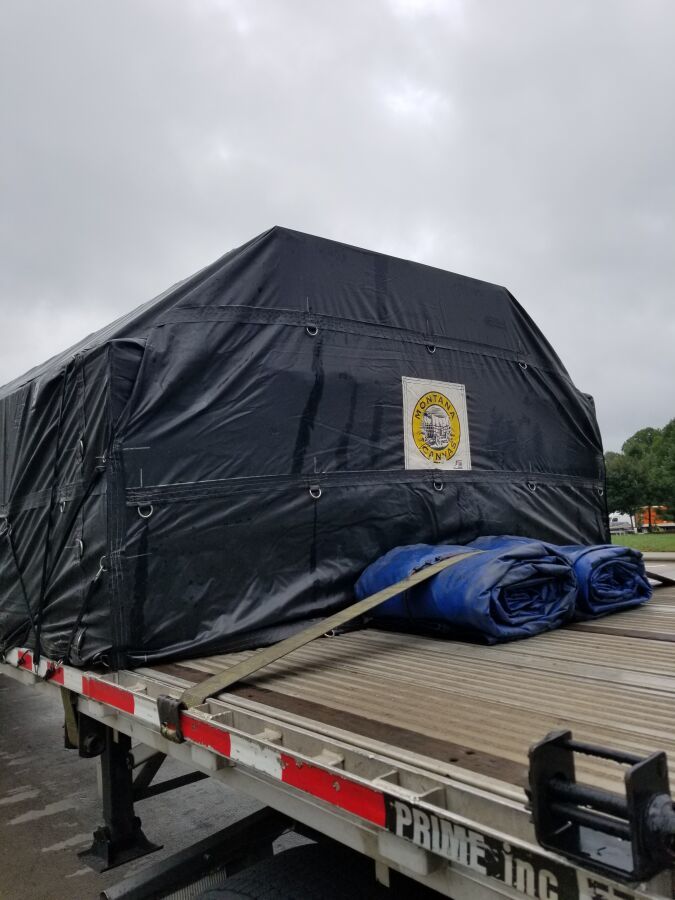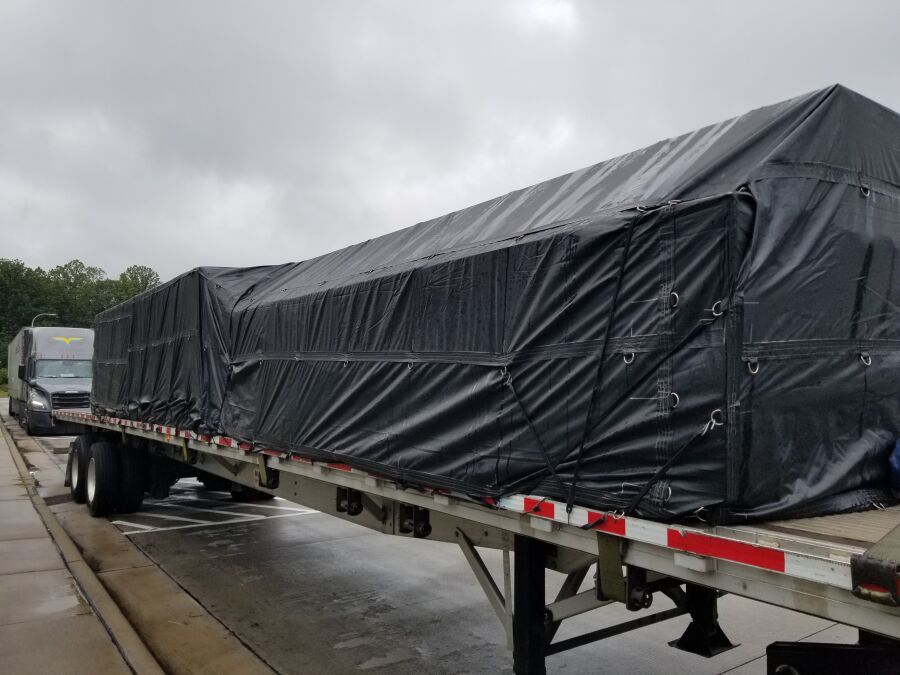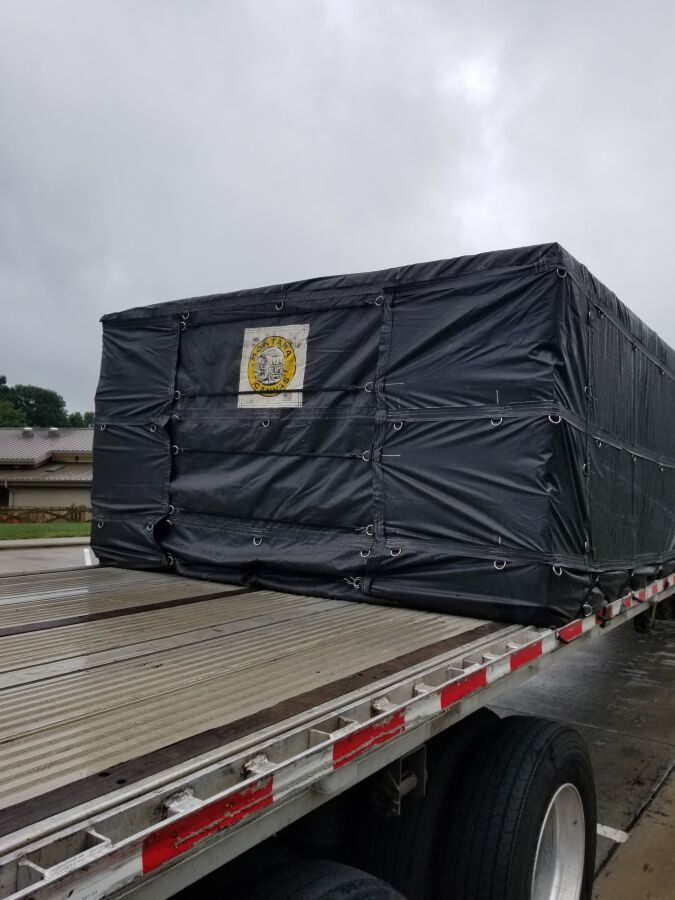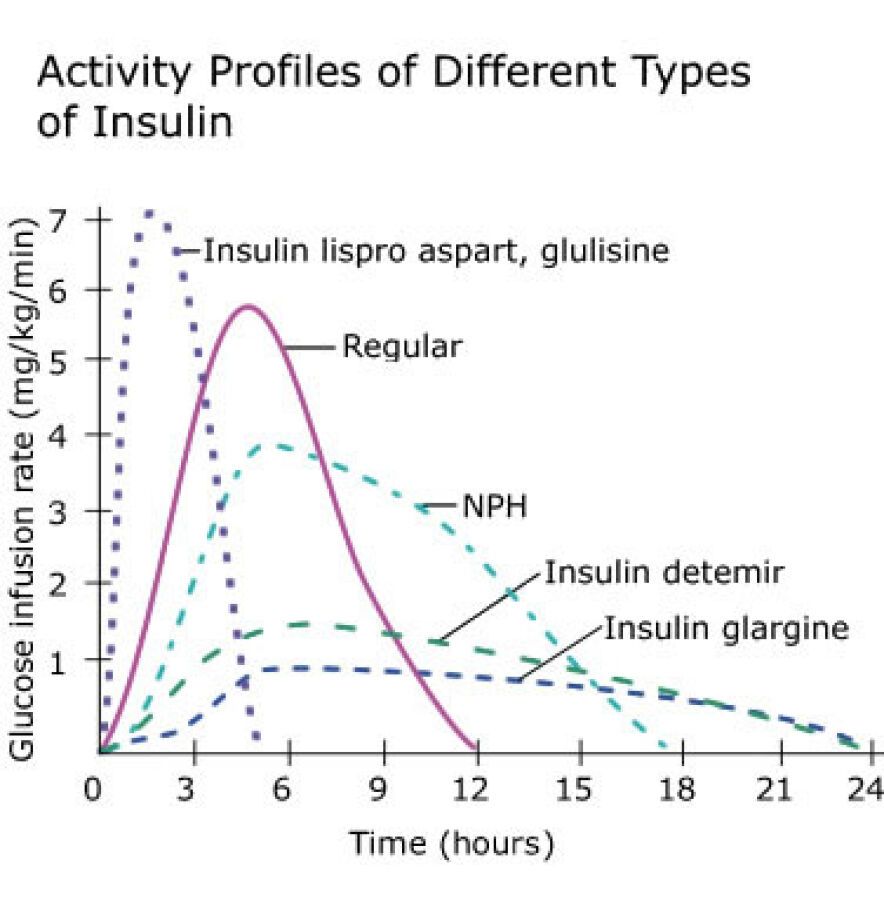Question For Those Of You That Do Flatbed
Topic 30712 | Page 2
First of all it's aluminum with sharp edges so you'd have to use a lot of protection, Iike moving blankets, or your tarps will get ripped. Second it's very tall and also very uneven. You see in the corner of the picture there's odd pieces of aluminum sticking out which makes it even more difficult to protect your tarps. And the load is generally uneven. This was in Cressona Pennsylvania and the guy at the shipper who was the "old hat" at tarping, even he looked at the load and complained about how they had loaded it.
Easy tarp loads are things like sheetrock that are square and don't require any protection for your tarps. Loads that require edge protection for your straps, protection for your tarps, and plastic covering, take a lot of time and are a hassle.
Shipper:
The customer who is shipping the freight. This is where the driver will pick up a load and then deliver it to the receiver or consignee.
Oh thanks that makes sense. Differently sounds like a PITA for sure
As a follow-up the pictures below are my most recent load of lumber. As you can see, it's not perfectly square but for the most part it's square enough to where your folds are fairly simple.



Pianoman, I've been thinking about your question. And it makes me start thinking of questions for you. My curiosity is about the diabetes part of this scenario. Admittedly, I don't know much about it. You have made some references to working construction and how that makes the management of your diabetes difficult. Is it the physical activities or is it the outdoor temperatures? Or is it a combination of them both that affects your blood sugar levels? Perhaps it is more related to not being able to eat when you need to? Forgive my ignorance, but I don't want us to be steering you in the wrong direction.
Depending on the length of your loads, and the products you are hauling, you could possibly be tarping and un-tarping two loads per day. That is quite a bit of physical work. We don't know what type account you are looking at. I do a dedicated flatbed account, but it is still pretty much an over the road situation. Yours sounds as if it is more regional which could involve a lot more tarping, especially if all the loads have to be tarped. Remember we work outdoors much of the time. We tarp in the summer heat and in winter's snow and ice. We sometimes have days go between loads before even having to tarp a load. I can't tell about what you are looking into.
I'm not sure where I am going with this other than I think you need to consider all the ramifications of the job. I wouldn't want to encourage you to do this if it is going to make it really difficult on your health. I have seen what diabetes can do to people when it is not managed properly. That is not a pretty picture. We wish you the best, but know that you will know best concerning what you can deal with. Tarping itself is not that bad, but Chief Brody makes some good points about how different loads can certainly be frustrating and time consuming. Just put your mind to it and maybe ask some questions to some drivers on the account you are looking at. I'd want to know before I jumped in just how much tarping is involved and what the various loads are like.
I have seen guys on a dedicated sheet-rock account where most of their loads are actually tarped for them. They have to finish it up with some bungees and un-tarp it at the receiver. That would probably work really well for you. I just don't know enough to feel like we can give you the best advice. If it is a regional flatbed job with all sorts of flatbed work then you may have a good many loads that don't need to be tarped. Can you give us a little more information about what the job actually is?
Regional:
Regional Route
Usually refers to a driver hauling freight within one particular region of the country. You might be in the "Southeast Regional Division" or "Midwest Regional". Regional route drivers often get home on the weekends which is one of the main appeals for this type of route.
Over The Road:
Over The Road
OTR driving normally means you'll be hauling freight to various customers throughout your company's hauling region. It often entails being gone from home for two to three weeks at a time.
Dm:
Dispatcher, Fleet Manager, Driver Manager
The primary person a driver communicates with at his/her company. A dispatcher can play many roles, depending on the company's structure. Dispatchers may assign freight, file requests for home time, relay messages between the driver and management, inform customer service of any delays, change appointment times, and report information to the load planners.Pianoman, I think you’ll be just fine in regards to flatbed work. CNC machines are one of the more difficult things anyone ever has to tarp, along with pumping stations and you’ll not likely see either of those with what you’ve described. That aluminum load that was posted really wasn’t all that bad and if the driver didn’t like the way they loaded it, he should have told them to fix it or take it off the truck. As far as needing 4 tarps, they must have been small ones because it could have easily been handled with 2-8’ drops.
HOS:
Hours Of Service
HOS refers to the logbook hours of service regulations.Chief Brody... cool stuff man, thanks for the pictures.
And Robert, thanks for chiming in. Appreciate the additional perspective.
Old School wrote:
Pianoman, I've been thinking about your question. And it makes me start thinking of questions for you. My curiosity is about the diabetes part of this scenario. Admittedly, I don't know much about it. You have made some references to working construction and how that makes the management of your diabetes difficult. Is it the physical activities or is it the outdoor temperatures? Or is it a combination of them both that affects your blood sugar levels? Perhaps it is more related to not being able to eat when you need to? Forgive my ignorance, but I don't want us to be steering you in the wrong direction.
Old School, you asked some really good questions. The short answer is yes, yes, and yes lol. I'd have to write a book to give you the long answer, no joke. The problem is that literally everything affects blood sugar and it is impossible to keep blood sugar in range all the time. Even the most in control diabetics I know still have highs and lows. The easiest and most effective way to control blood sugar is too control my environment and create a routine because blood sugar management requires planning. Insulin doesn't react immediately and in most cases food impacts blood sugar faster than insulin does. Not every insulin is the same either. I'll try to attach a graph my doctor recently showed me that demonstrates the way different insulins impact blood sugar over several hours. Some are a smooth curve, some are flat, some spike after a couple hours and then wear off earlier. Same thing with food--it's really all over the place.
Here's the crazy part: I have always been pretty active and if I plan for it I can do totally normal things like run, workout, etc, and I'll regularly go for hour long bike rides even in the heat and be fine as long as I plan for it. Where construction gets funky is in the fact that I'm at work for 8 hours or more, so I can only plan so much. I usually avoid eating when I'm working out because taking insulin during exercise can double or triple the effectiveness of the insulin and cause low blood sugar. I can do that if it's a few hours but I can't go all day without eating when I'm sweating my butt off doing manual labor in 95 degree weather in the sun. It also has to do with the varying activity level, how strenuous it is, and how well I can plan for it. In my previous job, I never knew if I was going to be inside on a lift just wiring some things up or if I would be outside in the sun lifting heavy materials and moving them around. Those two activities have very different effects on my levels, especially if I've recently taken insulin. If I eat lunch and take a little bit of insulin and go inside and start working I know that's what I'm going to do, I can usually keep my level under control. But if I take the same amount of insulin thinking I'm going to be working inside and then get sent outside to do something like move around a bunch of materials in the sun instead, my blood sugar is almost definitely going to go low. And when it goes low I lose my strength--I can still do a little bit but continuing to work without taking a break will keep my blood sugar low and I literally won't have the strength to lift heavy things anymore.
Sorry I know this is long-winded but there's really no short answer to your question than just saying yes all those things affect blood sugar. But hopefully that helps explain why it's not so much about how strenuous the job is (that does still play a factor) but it's definitely more about how well I can plan for the activity level and still be able to control my blood sugar. It will also help to be back on insurance and be able to use an insulin pump and CGM (continuous glucose monitor) again as those allow more flexibility in the life of a diabetic. I won't go into details on those but you can google them and find alot of information if you want to know more about them.
Based on the information I have I think flatbed would probably be just fine, especially once I'm able to get back on an insulin pump. A few hours of even very demanding physical labor is much easier to plan for diabetes-wise than 8-10 hours of varying amounts of physical labor even if not all that strenuous. Hopefully this also helps explain why I was looking into food service. Sure, it's 10-14 hours shifts of physical work, but it's easier to plan for because you know exactly what you're going to be doing at each stop and it's not crazy strenuous either to where it will have huge impacts on blood sugar. For example when I worked as yard hostler I still had to deal with the highs and lows but it was all one type of work and I was usually pretty busy so I was mostly able to manage my blood sugar pretty well while doing that job. A position at the same company that didn't work very well for me was OTR furniture delivery. I was making bookoo bucks but it was suuuuuper hard to manage blood sugar (even with an insulin pump and cgm) because I would go from sitting in the truck for hours at a time to very, very physical work and we never really knew how long a stop was going to take. Deliveries could range anywhere from a few minutes to all day depending on how much they ordered.
(continued below)
OTR:
Over The Road
OTR driving normally means you'll be hauling freight to various customers throughout your company's hauling region. It often entails being gone from home for two to three weeks at a time.
Dm:
Dispatcher, Fleet Manager, Driver Manager
The primary person a driver communicates with at his/her company. A dispatcher can play many roles, depending on the company's structure. Dispatchers may assign freight, file requests for home time, relay messages between the driver and management, inform customer service of any delays, change appointment times, and report information to the load planners.HOS:
Hours Of Service
HOS refers to the logbook hours of service regulations.(continued...)
Another job that worked pretty well for the most part was my mountain driving position. I never touched the freight but I did have to get out and chain up and down alot during the winter. Even just going from the warm truck to the cold to back in the truck has an impact on blood sugar but I was able to control it for the most part despite not always knowing when I was going to be chaining up or not.
Part of the reason why I have been looking at local jobs and avoiding regional and especially otr gigs for the most part is that I do want something that is at least a little physical. Sitting in the truck all the time can also make it difficult to control blood sugar because insulin takes alot longer to take effect when you're sedentary. So if I eat something and my blood sugar starts going high, it might stay elevated for a several hours before it finally comes back down. All the prolonged highs over time is the quickest way to start running into long term complications for diabetes.
I know that's a ton of information but it really doesn't even scratch the surface of everything that goes into diabetes management. I didn't even talk about the impact of different diets, daily exercise, stress, the stupid heat wave this summer, sleep schedule, etc. Seriously, type I diabetes is a huge PITA and there is no job that is perfect. The only reason I'm asking so many questions and being so picky is that I can. One of the wonderful things about trucking is that there is such a huuuuuge variety of jobs out there and it's not usually too hard to find a job that suits your specific needs and also pays well. Whatever company I end up going with, I don't want to leave as long as I'm still in trucking, so finding a job that generally doesn't mess with diabetes management too much is important to me. Thankfully with the modern insulins and diabetes management technology that are available today, as long as I have insurance to afford that insulin and technology I do have quite a bit of flexibility in what job I work. I'm mainly just trying to avoid a super hard job physically right after having several consecutive months of feeling like poop because of the insulin I was using and the job I was working.
Hopefully that's helpful. Most people don't know anything about type I diabetes so I'm happy to help educate whenever I can.
Here's that graph I was telling you about earlier:

Regional:
Regional Route
Usually refers to a driver hauling freight within one particular region of the country. You might be in the "Southeast Regional Division" or "Midwest Regional". Regional route drivers often get home on the weekends which is one of the main appeals for this type of route.
OTR:
Over The Road
OTR driving normally means you'll be hauling freight to various customers throughout your company's hauling region. It often entails being gone from home for two to three weeks at a time.
OWI:
Operating While Intoxicated
Thanks Pianoman!
I appreciate your response. I can see you really are taking this seriously and putting a lot of thought into it. Your response was incredibly helpful. I think a lot of diabetics will appreciate what you laid out here for us. You guys have some challenges that most of us never encounter out here on the road. I congratulate you on your efforts at making this all work.
Thanks Pianoman!
I appreciate your response. I can see you really are taking this seriously and putting a lot of thought into it. Your response was incredibly helpful. I think a lot of diabetics will appreciate what you laid out here for us. You guys have some challenges that most of us never encounter out here on the road. I congratulate you on your efforts at making this all work.
Thanks Old School, appreciate your insight as well. I was hoping you would chime in on this thread as you are the resident master flatbedder on the forum.
Oddly enough, one of the places I'm considering is actually going back to my old Target dedicated gig at Swift haha. My old boss was at the job fair I went to and she really wants me back. If the pay works out I just might. Diabetes-wise it was about as ideal as it gets. One to two hours of driving to the various stores, 15-30 minutes to drop and hook , then back in the truck. If it had paid better I never would have left.
Drop And Hook:
Drop and hook means the driver will drop one trailer and hook to another one.
In order to speed up the pickup and delivery process a driver may be instructed to drop their empty trailer and hook to one that is already loaded, or drop their loaded trailer and hook to one that is already empty. That way the driver will not have to wait for a trailer to be loaded or unloaded.
New Reply:
New! Check out our help videos for a better understanding of our forum features

















Preview:
This topic has the following tags:
Choosing A Trucking Company Dedicated Jobs Flatbed Local CDL Drivers Regional Jobs







 TT On Facebook
TT On Facebook
Help a non-flatbedder out lol, what makes this load something you wouldn't want to haul every day? Is it the four tarp part?
I do love seeing all the different kinds of loads in the flatbed thread and it's one of the things that does kinda attract me to flatbed. Flatbedders are cool as hell.